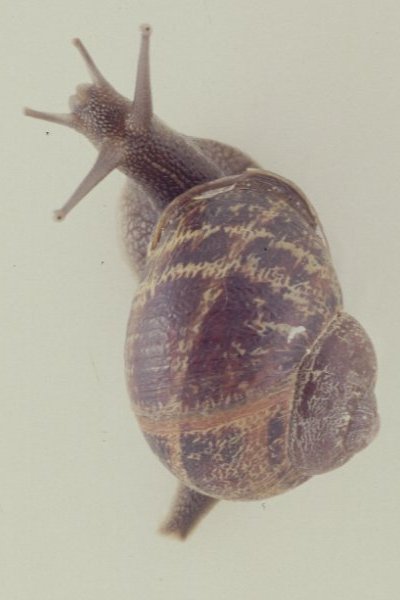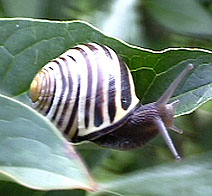
Pulmonata
| Palaeos |  |
Gastropoda: Pulmonata |
| Mollusca | Stylommatophora |
| Page Back | Unit Up | Clade Up: Pulmonata | Page Next |
| Unit Back | Clade Down: None | Mollusca References | Unit Next |
|
Abbreviated Dendrogram
GASTROPODA |--Caenogastropoda `--Heterobranchia |--Opisthobranchia | `--PULMONATA |==Basommatophora `--+--Stylommatophora `--+--Systellommatophora `==Acteophila |
Contents
Overview |

The higher pulmonates, or Stylommatophora, are a successful clade that far outnumber the Basommatophora in species. This order, the most advanced and specialized of all the pulmonates, includes most land snails and slugs represent one of the major metazoan invasions of the land, comprising some 30,000 to 35,000 species (with many more probably awaiting discovery) - almost equivalent to vertebrates as a whole. They include the familiar garden snail and slug, but also thousands of less known species. They Stylommatophora are major components of many terrestrial ecosystems, and have also become important models for studies on the mechanisms of evolution and biogeographic studies (Wade, iNet). They frequently occur beneath leaf litter, stones and bark, and are especially abundant on oceanic islands, such as the Pacific [Barnes 1980 p.340]. The name "Stylommatophora" means "slender eye-bearing stalk", and refers to the fact that these animals have two pairs of tentacles, with eyes located at the tips of the upper (posterior / dorsal), pair, rather than at the base, as is the case with the Basommatophora. All species are terrestrial, and many are locally abundant. Although most stylommatophores feed on plants and detritus, a few are carnivores that feed on other snails. Chase 2002 p.15

Agathylla biloba (A. J. Wagner 1914)
(Sigmurethra - Clausilioidea - Clausiliidae - Alopiinae]
Photo © V. Wiese, Haus der Natur Cismar, from Albanian non-marine molluscs
Most species have thin to moderately thick calcareous conispiral shells, which range from very low-spired to steep-sided, high-spired forms. A majority have many whorls, generally but not always more than among basommatophorans. [Moore, et al 1952, p.332]. There are also includes shell-less slugs and semi-slugs with residual shells that are too small to accommodate the body. In fact, as with the Opisthobranchia, shell reduction has occurred independently a number of times in different lineages. Slugs seem to have evolved in environments of low calcium and high humidity [Barnes 1980 p.340].
The aperture usually has a rather evenly rounded outer lip, often with a thickened rim. Tooth-like projections of the inner lip, and in some shells of the outer lip also, serve to keep out predators such as insects but allow the soft snail to squeeze through [Barnes 1980 p.340]. . Such features especially characterize genera of the Pupidae, and largely because of the close resemblance of some Pennsylvanian non-marine gastropods to the modern Pupa, these Paleozoic fossils were at one time thought to belong among the stylommatophorans [Moore, et al 1952, p.332]. This is now no longer believed to be the case, and it is generally agreed that the Pulmonates, including the Stylommatophora, evolved much later, during the Jurassic period. [Clarkson, 1979 p.163]
Most Stylommatophora are fairly small, averaging less than a centimeter in shell length or width, although the giant African snail Achatina achatina, have shells that reach 27 cm [Barnes 1980 p.340]
In terms of diversity, they are the largest clade of gastropods, with some 35,000 species, and from 71 to 92 families, depending on the classification scheme used (Bieler, 1992; Wade et al., 2001). Part of this diversity may be due to the fact that local populations easily become isolated, as the animals move slowly, and have little need to migrate. This leads to both greater speciation and greater intraspecific genetic variation [Chase 2002 pp.13-14 ]. According to Thomaz et al., 1996, Cepaea nemoralis has the most extreme intraspecific variation of mitochondrial DNA of any animal.

the European land snail Cepaea nemoralis
(Sigmurethra - Helicoidea - Helicidae - Helicinae]
Earliest Pleistocene to Recent
Width and height of shell about 2 cm.
This very variable European species is found throughout the world. See Snail Species - the Family Helicidae for more.
The monophyletic composition of the Stylommatophora has been confirmed by molecular analysis of ribosomal RNA (Wade & Mordan, 2000, Wade et al., 2001).
The origins and the deep-level evolutionary relationships of their major groupings within the Stylommatophora are controversial, with anatomical studies giving confusing and conflicting results. The following arrangement from Jeffery 2001 (contrast with older classification by ![]() Abbott & Dance, 2000) has been modified in the light of molecular research by
Chris Wade involving ribosomal RNA gene sequencing. Dr Wade's research reveals a single assemblage including the families Achatinidae, Subulinidae and Streptaxidae near the base of the group, forming a sister group to all remaining stylommatophorans and dividing the order into 'achatinoid' and 'non-achatinoid' taxa. The Orthurethra appear to be relatively advanced within the 'non-achatinoid clade', and broadly equivalent to other super-familial clusters, indicating that supposedly primitive features such as the orthurethran kidney are in fact derived. (Wade, iNet)
Abbott & Dance, 2000) has been modified in the light of molecular research by
Chris Wade involving ribosomal RNA gene sequencing. Dr Wade's research reveals a single assemblage including the families Achatinidae, Subulinidae and Streptaxidae near the base of the group, forming a sister group to all remaining stylommatophorans and dividing the order into 'achatinoid' and 'non-achatinoid' taxa. The Orthurethra appear to be relatively advanced within the 'non-achatinoid clade', and broadly equivalent to other super-familial clusters, indicating that supposedly primitive features such as the orthurethran kidney are in fact derived. (Wade, iNet)
I have also modified the Linnaean ranking in keeping with the standard ordinal grade normally given to the Stylommatophora
Although the molecular tree also suggests that the origin of the Stylommatophora is much earlier than the main period of their diversification (Wade, iNet), this may simply (as with the Cambrian explosion and other important events) be a result of evolutionary heterochrony.
Order STYLOMMATOPHORA
'achatinoid' taxa (unnamed clade).
Achatinoidea (formerly included under Sigmurethra)
Achatinidae Swainson, 1840
Coeliaxidae Pilsbry, 1907
Ferrussaciidae Bourguignat, 1883
Glessulidae Schileyko, 1996
Subulinidae Thiele, 1931
Thyrophorellidae Thiele, 1926
'non-achatinoid' taxa (unnamed clade)
Suborder SIGMURETHRA
Buliminoidea
Buliminidae Clessin, 1879 [?Pfeiffer, 1879] [=Enidae Woodward, 1903, in part]
Cerastuidae Wenz, 1923 [=Enidae Woodward, 1903, in part]
Clausilioidea
Clausiliidae Mörch, 1864
Triptychiidae ?author
Orthalicoidea [=Bulimulacea]
Orthalicidae Albers-Martens, 1860
Amphibulimidae Crosse & Fischer, 1873
Anadromidae Zilch, 1959
Cerionidae Pilsbry, 1901 [=Ceriidae]
Coelociidae Nordsieck, 1986
Grangerellidae Russel, 1931
Megaspiridae Pilsbry, 1904 [=Coelociontidae Iredale, 1937]
Microceramidae Pilsbry, 1903
Odontostomidae Pilsbry & Vanatta, 1898
Urocoptidae Pilsbry & Vanatta, 1898 [?1896]
Aillyoidea
Aillyidae Baker, 1930
Oleacinoidea
Oleacinidiae Adams & Adams, 1855
Spiraxidae Baker, 1939
Testacellidae Gray in Turton, 1840
Streptaxoidea
Streptaxidae Gray, 1806
Strophocheiloidea
Strophocheilidae Thiele, 1926
Dorcasiidae Thiele, 1926
Megalobulimidae Leme, 1973
Acavoidea
Acavidae Pilsbry, 1895
Caryodidae Thiele, 1926
Macrocyclidae Thiele, 1926
Megomphicidae Baker, 1930 [=Ammonitellidae ?author]
Rhytidoidea
Rhytididae Pilsbry, 1893 [?1895; =Paryphantidae ?author]
Aperidae ?author [=Chlamydephoridae Cockerell, 1935]
Haplotrematidae Baker, 1925
Systrophiidae Thiele, 1926 [=Scolodontidae Baker, 1925]
Plectopylidoidea
Plectopylididae Moellendorf, 1900 [=Corillidae ?author]
Sculptariidae ?Vaught, 1989
Arionoidea
Arionidae Gray in Turton, 1840
Philomycidae Gray, 1847
Punctoidea [=Endodontoidea]
Punctidae Morse, 1864
Charopidae Hutton, 1884
Discidae Thiele, 1931
Endodontidae Pilsbry, 1895
Helicodiscidae Baker, 1927
Oopeltidae Cockerell, 1891
Oreohelicidae Pilsbry, 1939
Otoconchidae Cockerell, 1893
?Philiomycidae ?author
Sagdidoidea
Sagdidae Pilsbry, 1895 [=Sagdididae Tracey, Todd & Erwin, 1993]
Gastrodontoidea
Gastrodontidae Tryon, 1866
Helixarionoidea [=Helicarionoidea]
Helixarionidae Bourguignat, 1883 [=Helicarionidae Bourguignat, 1883 & Godwin & Austen, 1883/8]
Ariophantidae Godwin-Austen, 1888 [?Germain, 1921]
Cystopeltidae ?Vaught, 1989
Dyakiidae ?author
Euconulidae Baker, 1928 [?Strebel & Pfeffer]
?Sesaridae ?author
Trochomorphidae Moellendorf, 1890
Urocyclidae Simroth, 1889
Vitrinoidea [=Zonitoidea]
Vitrinidae Fitzinger, 1833
Daudebardiidae Kobelt, 1906
Milacidae Ellis, 1926 [?Germain, 1930]
Parmacellidae Gray, 1860
Plutoniidae Wiktor & Backeljau, 1995
Plutoniinae Cockerell, 1893
Zonitidae Mörch, 1864
Limacoidea
Limacidae Rafinesque, 1815
Agriolimacidae Wagner, 1935
Boetgerillidae ?author
Thyphorellidae ?author
Trigonochlamydoidea
Trigonchlamydidae Hesse, 1882
?Papillodermidae Wiktor, Martin & Castillejo, 1990
Polygyroidea [=Mesodontoidea]
Polygyridae Pilsbry, 1894/5 [?1940] [=Mesodontidae Tryon, 1866]
Thysanophoridae Pilsbry, 1926
Camaenoidea
Camaenidae Pilsbry, 1895
Solaropsidae Nordsieck, 1986
Helicoidea [=Xanthonychoidea]
Helicidae Rafinesque, 1815
Cochlicellidae Schileyko, 1972 {from Cochlicellinae (Hygromiidae)}
Eulotidae Moellendorf, 1898 [=Bradybaenidae Pilsbry, 1934]
Hygromiidae Tryon, 1866 [=Helicellidae ?author]
Monadeniidae Schileyko, 1996
Monadeniinae Nordsieck, 1987
Sphincterochilidae Zilch, 1960
Xanthonychidae Strebel & Pfeffer, 1880 [?=Helminthoglyptidae Pilsbry, 1939]
Suborder ORTHURETHRA
Achatinelloidea
Achatinellidae Gulick, 1873 [?=Pacificellidae Steenberg, 1925]
Cochlicopoidea [=Cionelloidea]
Cochlicopidae Pilsbry, 1900 [=Cionellidae ?author]
Amastridae Pilsbry, 1911
Pupilloidea
Pupillidae Turton, 1831
Chondrinidae Steenburg, 1925
Orculidae Pilsbry, 1918
Pleurodiscidae Wenz, 1923
Pyramidulidae Kennard & Woodward, 1914
Strobilopsidae Pilsbry, 1918
Valloniidae Morse, 1864 [?Pilsbry, 1900]
Vertiginidae Fitzinger, 1833 [?Stimpson, 1851]
Partuloidea
Partulidae Pilsbry, 1900
?Succineoidea [=Heterurethra]
Succineidae Beck, 1837
?Athoracophoroidea [=Tracheopulmonata]
Athoracophoridae Fischer, 1883
| Page Back | Page Top | Unit Home | Page Next |
page uploaded 24 December 2002
checked ATW051004